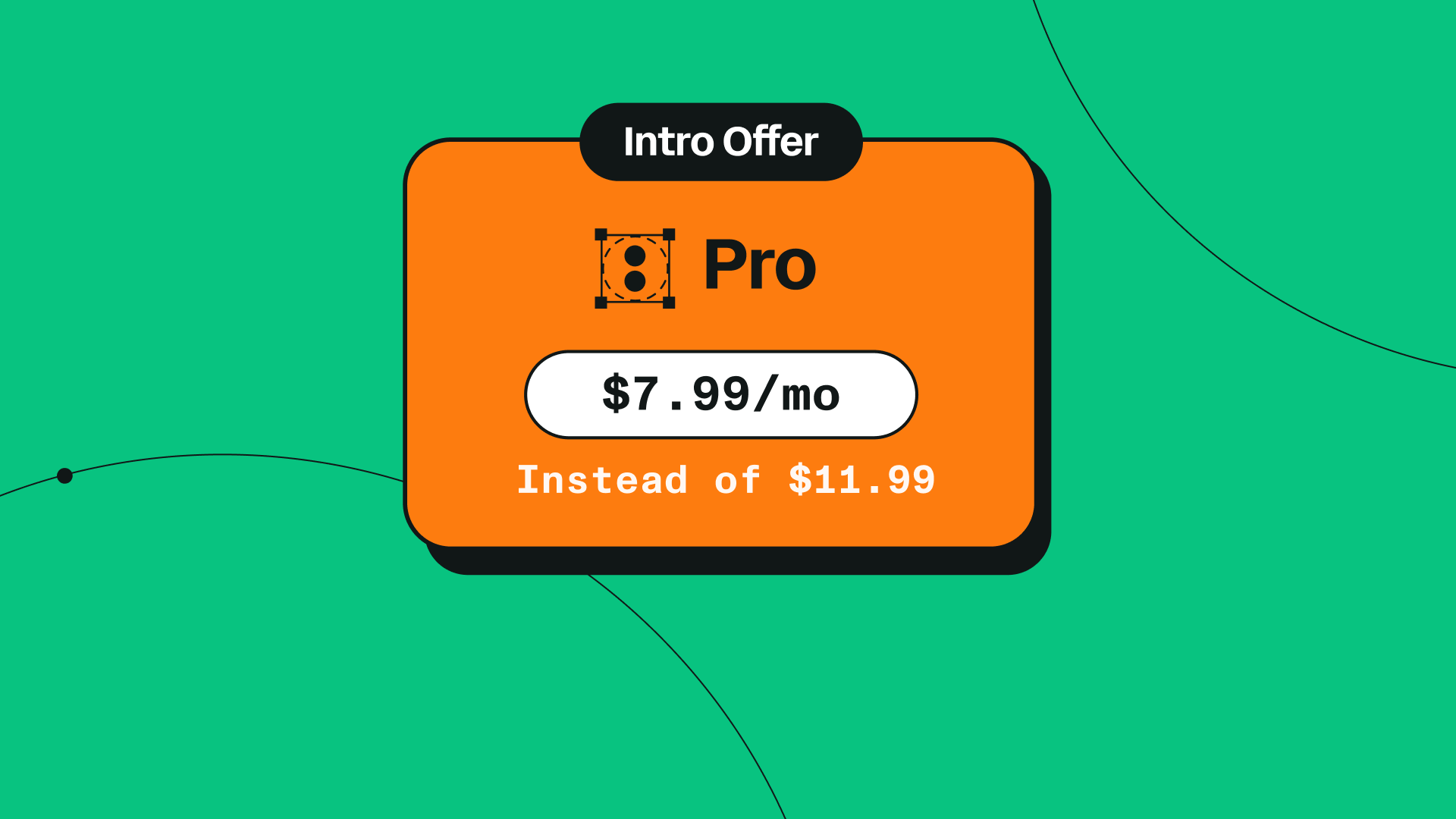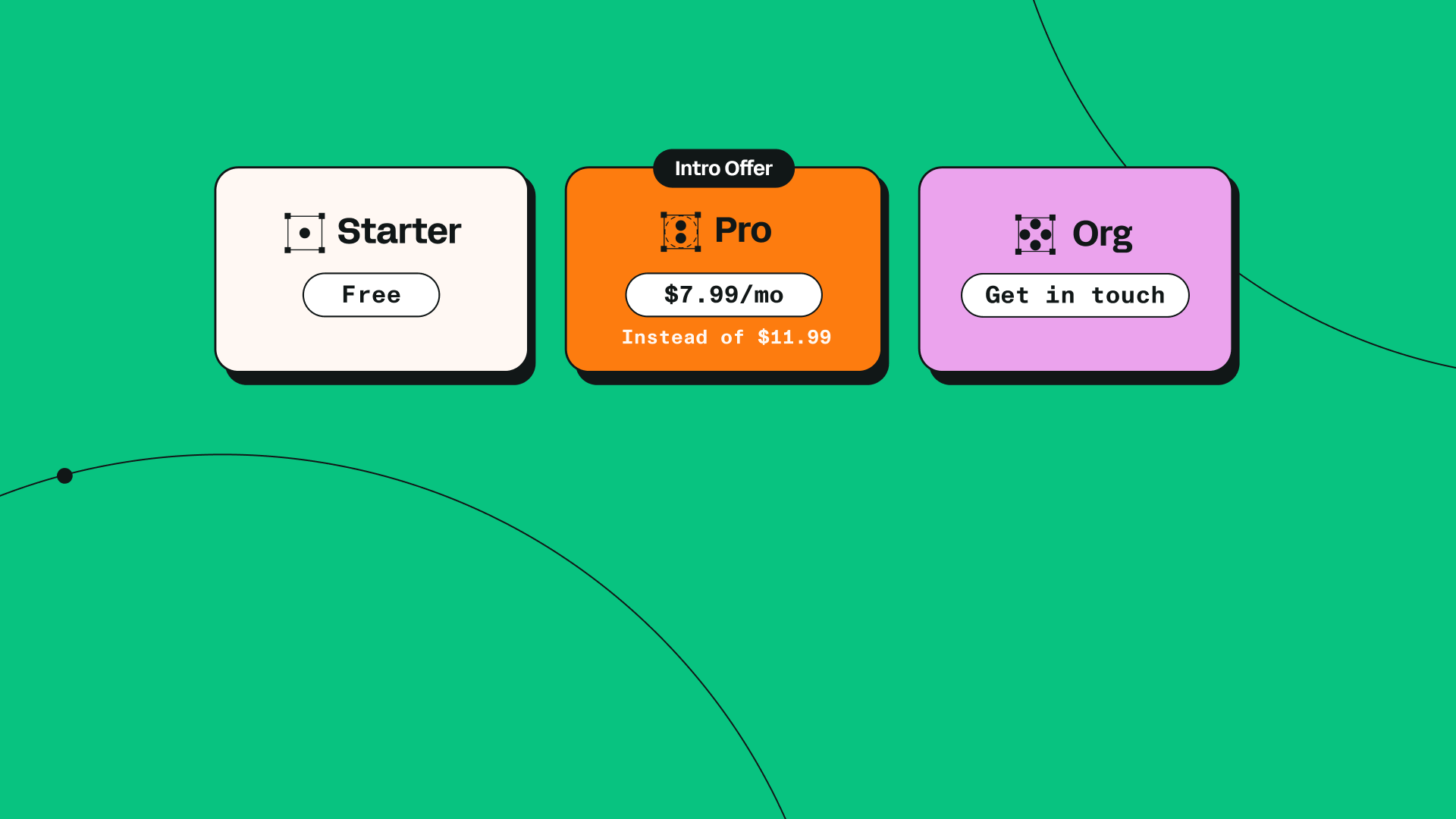Whether you're a school student, graphic design professional, or marketer, you'll love these enjoyable designs. In this post, we'll show you how to create bizarre, brightly-colored designs inspired by the 90s.

Images source: Unsplash
Two types of stickers: physical and digital
Stickers come in two primary forms, physical and digital.
A physical sticker is a label made from printed material, generally paper or vinyl plastic. It has a design on one side and an adhesive on the other surface.
Some stickers are made of metal or fabric, so your choice of surface depends on what's available at your print supplier. Stickers tend to go up in public spaces, so you also want to ensure you get eco-conscious, high-quality prints from your printers.
A digital sticker, on the other hand, is a small image file that can be used in social media posts, instant messaging, documents, and any other digital document or design file you can think of.
Both physical and digital stickers can be created using digital design software like Linearity Curve (formerly Vectornator).
Jumpstart
your ideas with
Linearity Curve
Take your designs to the next level.
Why choose sticker design
Stickers have powerful potential to grow your business or personal brand.
One of the big perks of stickers is adding them to a design without reworking anything. You can add physical stickers to product packaging, labels, and almost any fantastic inventions that would benefit from added details.
Digital stickers are incredibly effective and useful. They can be rapidly applied to as many elements or documents as necessary and redesigned or removed whenever needed.
Sticker types for businesses
As a business owner or marketer, you can use sticker design for:
- Custom labels
- Branded packaging seals
- Personalized gifts for customers
- Business decals on vehicles or other assets
- Branding materials
Stickers can be made in a large variety of shapes and sizes, and you can also order die-cut stickers that fit the contours of your designs perfectly.
You can also customize sticker labels and packaging to improve your customer experience. For example, adding arrows and "cut here" text to a packaging seal will help your customer understand how to open packaging correctly without damaging the goods inside.
Branded "Try Me" stickers indicate which demo products customers may open and try before they buy. This decreases waste while staying on-brand.
Another way stickers can help promote a positive customer experience is by adding customer service contact details to your branded packing tape. It encourages feedback and makes it easy for your customer to find out how to get in touch with your support team.
Personalized stickers for you
When it comes to your personal brand or creative output, you can print stickers to promote your designs or services.
Handing out cool stickers enables you to interact with potential customers or fans. This design asset may also offer more longevity compared to a business card.
Regardless of the sticker medium you choose, there are endless applications for these versatile and quirky labels. They're great for speedy branding solutions and adding personal touches to packaging and products.
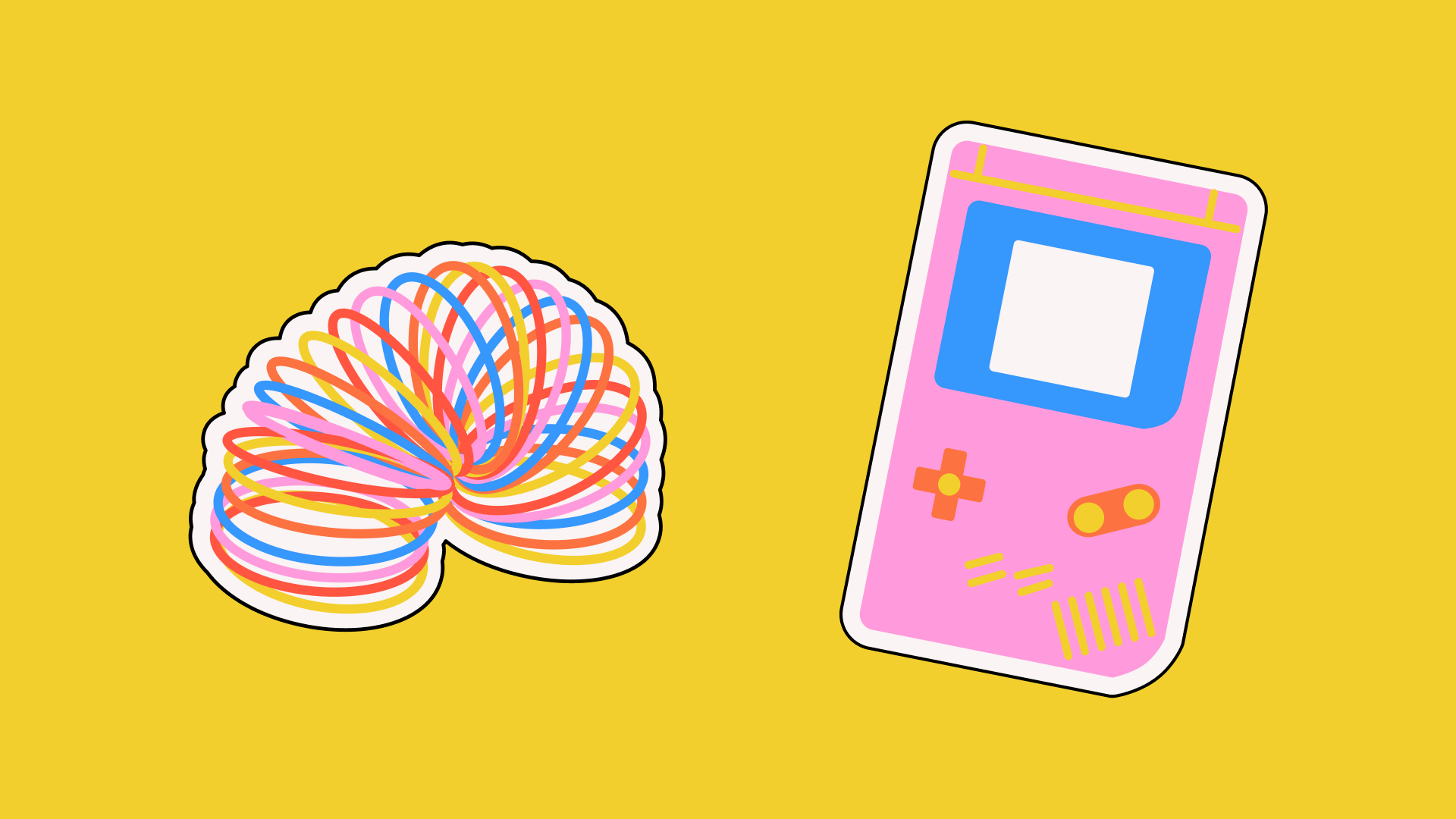
Design tools for creating stickers from scratch
You'll need graphic design software to create quality designs and sticker templates without sacrificing quality.
There are many software options out there. We'll highlight three top vector design tools for you to try (including our own software, Linearity Curve).
Linearity Curve (formerly Vectornator)
- Operating system: MacOS, iPadOS, iPhoneOS
- Top features: Image Mask, Shape Builder, Background Removal, Auto Trace, Cloud Storage
- Pricing: Free for individuals
Besides all the usual vector graphics tools (Pen, Node, and Shape Tools), Linearity Curve offers powerful features for creating complex designs and illustrations.
You can create and save custom color palettes, arrange and lock vector layers, and use one-click or one-tap options (such as image masking). If you want to create bespoke effects, you can also import custom brushes.
Vectornator is Now Linearity Curve
Your favorite design tool has evolved! Discover the new name and look with the same powerful features you love.
Linearity Curve was made for serious designers who want a powerful, easy-to-use software that streamlines their workflows. It's highly compatible with other design software, such as Adobe Illustrator, Figma, and Sketch.
Adobe Illustrator
- Operating system: MacOS, iPadOS, Windows, Web (Beta)
- Top features: Image masking and tracing, repeating patterns, layer management, compatibility with other Adobe tools
- Pricing: Starts at about $24 per individual per month
Adobe Illustrator, like Linearity Curve, is a robust graphic design software suitable for individuals and teams.
It boasts a large range of features for creating sophisticated designs and illustrations. As an integral tool in Adobe's Creative Suite, Illustrator has been an industry standard software for almost two decades.
But once you get the hang of the various workspaces and dropdown menu options, this software can be a valuable addition to your arsenal.
Figma
- Operating system: Web browser-based, macOS, iOS, iPad, Windows
- Top features: Cloud storage, CSS styling, design instances, template library, real-time collaboration
- Pricing: Starts at $12 per individual per month, limited free version
Compared to Linearity Curve and Adobe Illustrator, Figma is a strong competitor in the digital design software market.
Its main purpose is for UI/UX prototyping and web design, but many graphic designers have adopted this tool as their go-to graphic design software.
This software is a good option for web or product developers moving into a front-end role.
How to design a sticker with Linearity Curve
In this tutorial, our in-house designer Aysel teaches you how to design fun, '90s-inspired stickers on your iPad using Linearity Curve.
You can watch the full tutorial video above, or follow our step-by-step instructions below.
This tutorial shows you how to use the Offset Path Tool, which enables you to create evenly-spaced borders around your designs. These contours will inform the printer where to make each cut.
Sketch your designs
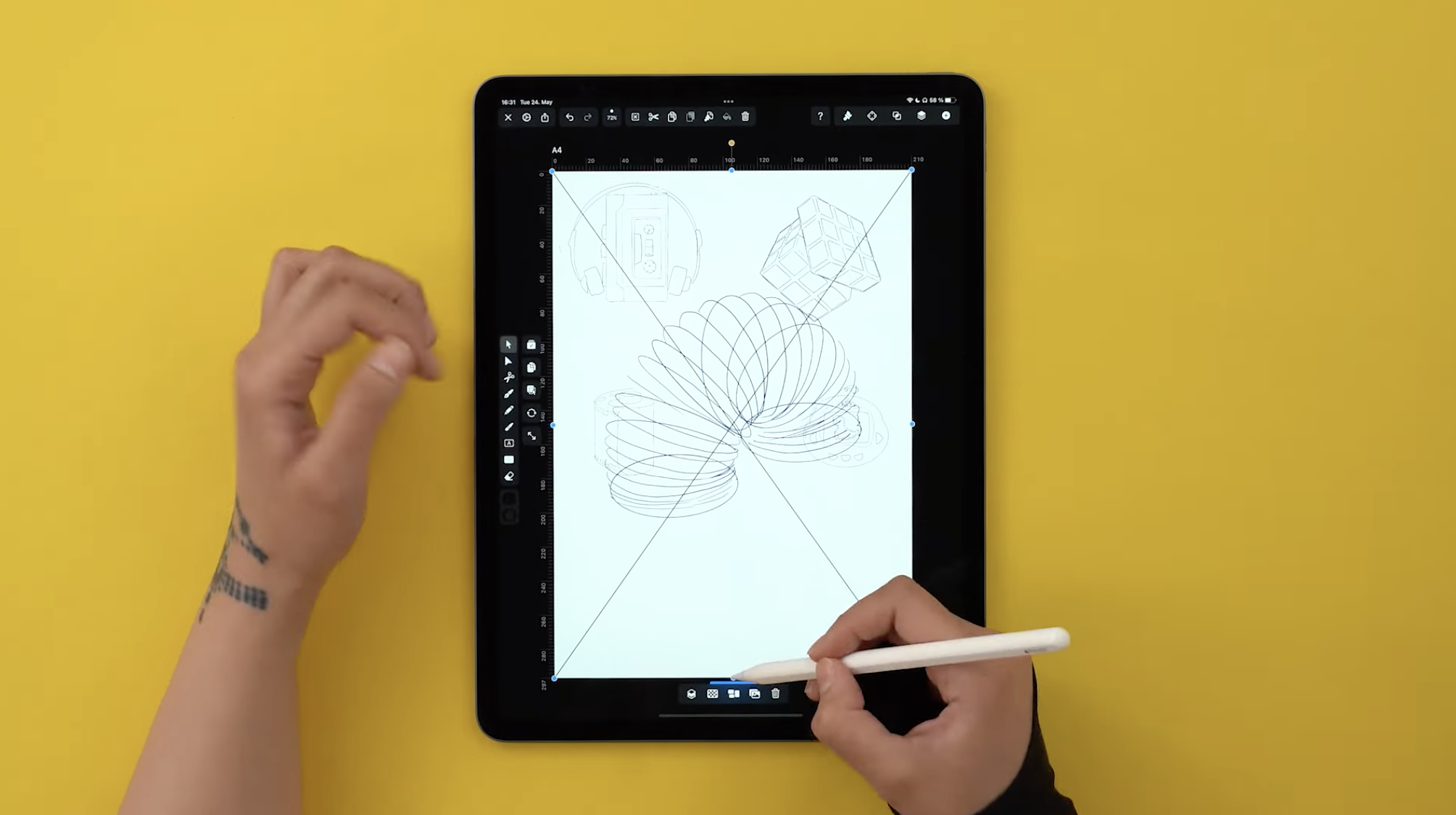
For our sticker designs, we were inspired by '90s nostalgia and iconic objects of the era.
Aysel sketched out seven original designs using graphic design software. These include a Walkman, a Tamagotchi, a Rubik's Cube, a Gameboy, some camera film, a Slinky toy, and a "90s baby" slogan motif.
But don't fret. You don't need Aysel's expertise in design to start making your own stickers. You can download her full-color design template below:
Alternatively, you can put your artistic skills to use and create your own sticker design elements.
Then, you can either draw over them or use Auto Trace to automatically turn your sketches into vector graphic images.
Choose your color palette
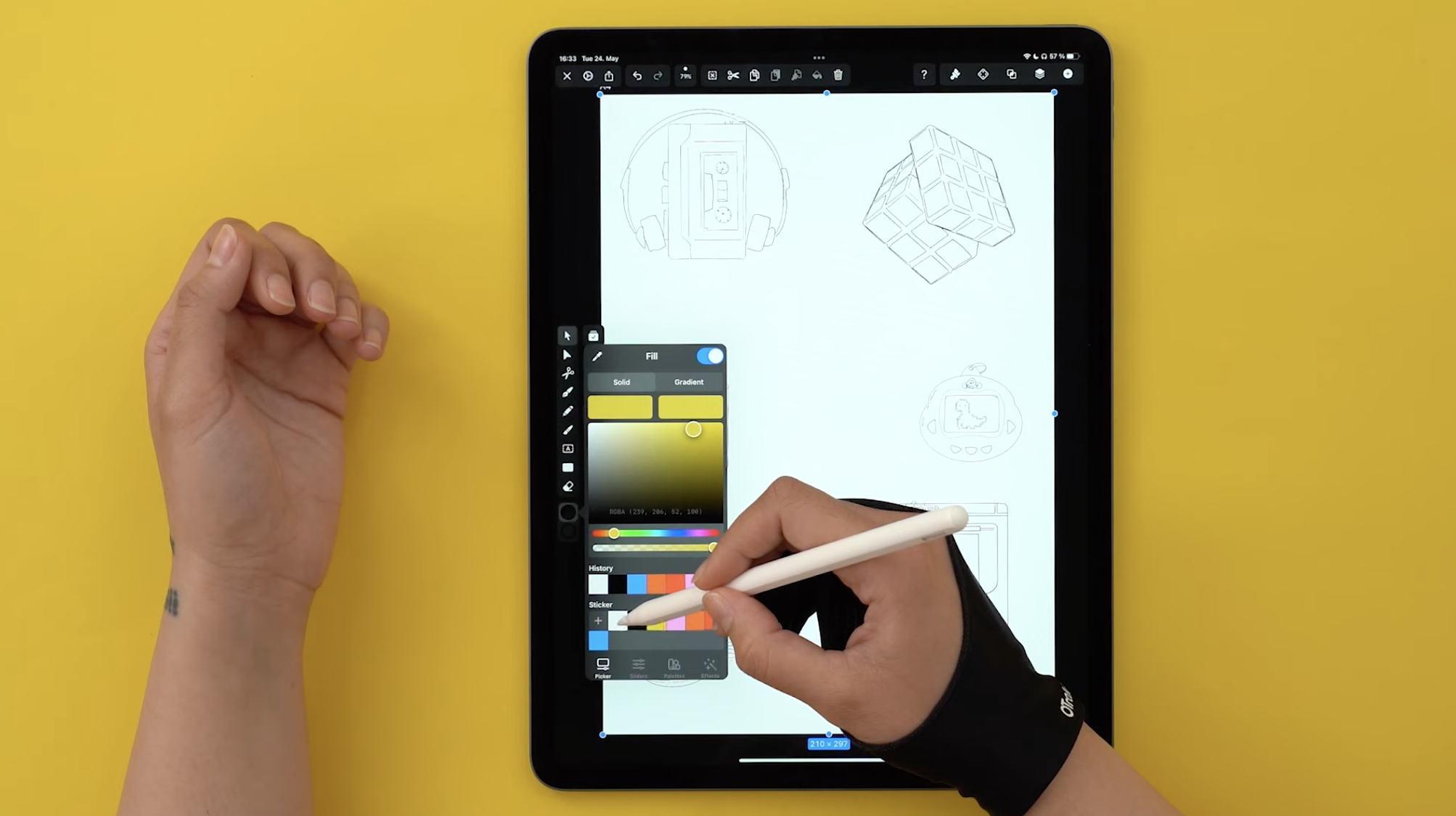
To design attention-grabbing stickers, choose a vibrant color palette with plenty of color contrast.
In Curve, you'll find a collection of default color palettes. From "Cotton Candy" to "Rainbow Power," our talented designers created them to suit different themes.
Vectorize your sketches
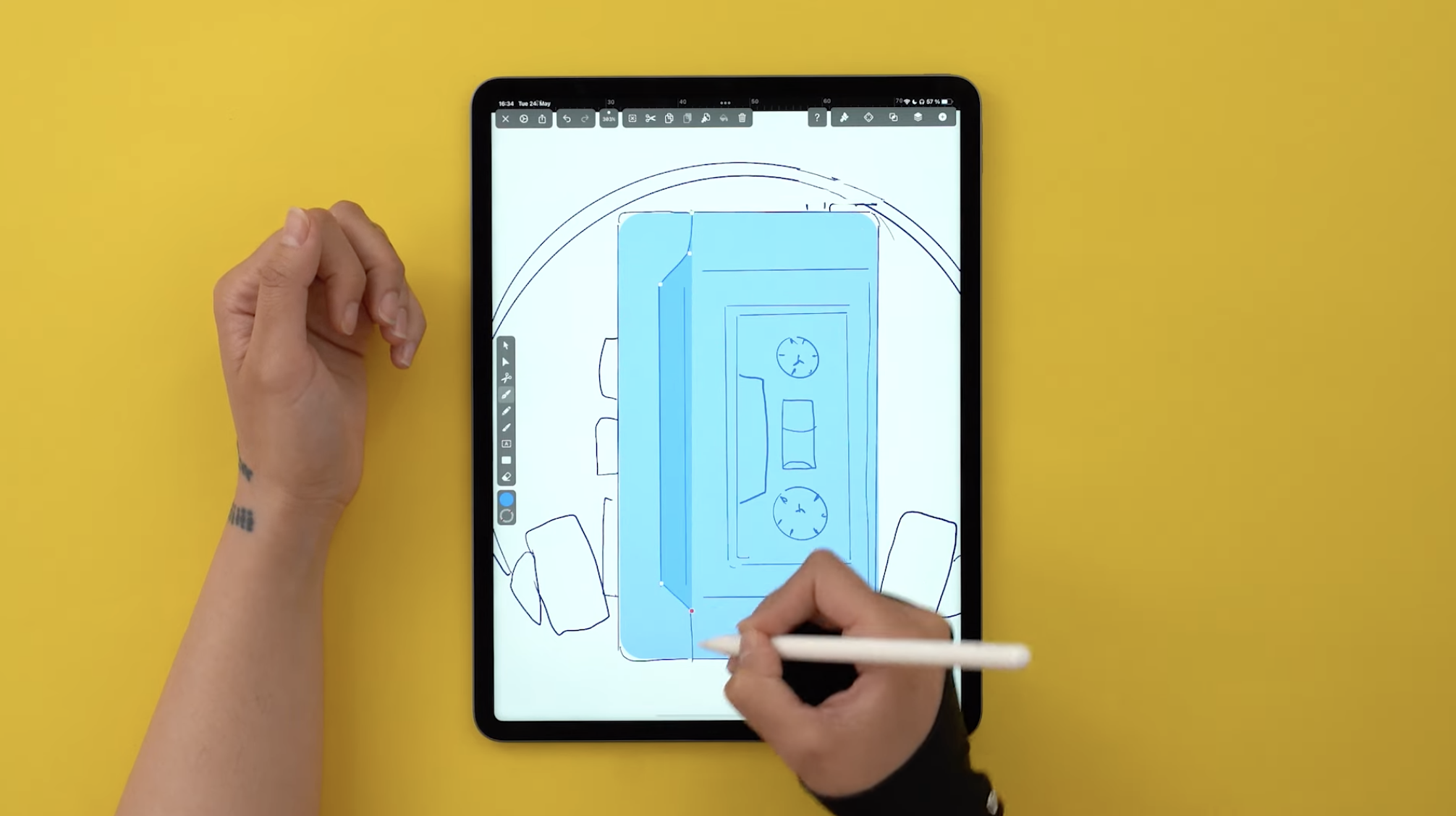
Once you're happy with your sketches, import them into Linearity Curve.
Now it's time to trace over your designs using vector tools. You can use a combination of the Shape Tool, the Pen Tool, the Pencil Tool, and masks to fill in your shapes and paths. Watch the video tutorial above to see how to do this.
Create white borders using Offset Path
Select the background element of each design. Next, you can go to the Path Tab located inside the Inspector. At the bottom of the feature list, tap Offset Path.
Use the slider to set the numerical value of the Offset Path. Aysel set it at 9 pts on each design.
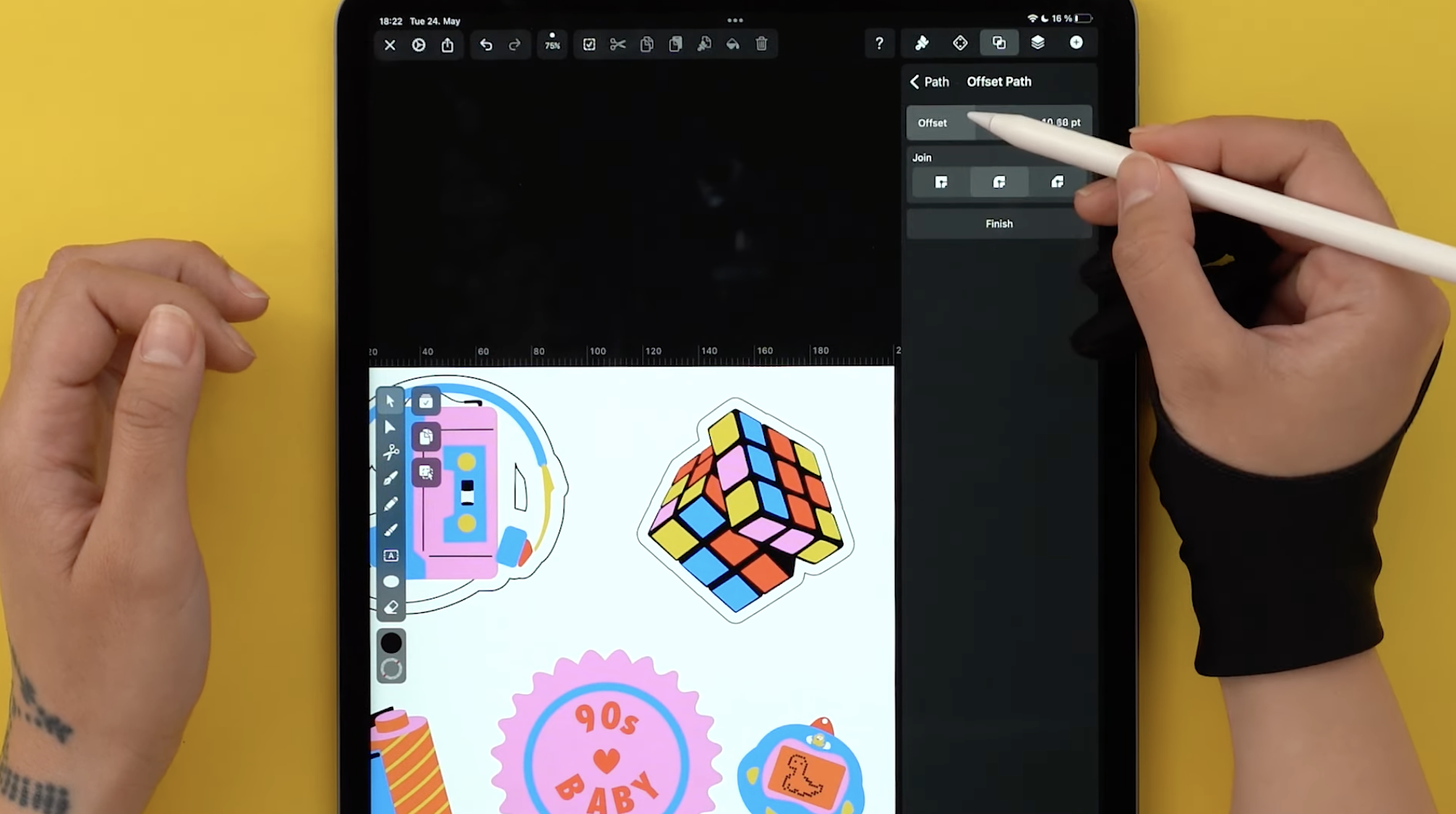
Your sticker designs are complete. Now all you have to do is print your sticker sheet on self-adhesive paper and decide where you want to stick your designs.
Best practices for sticker design
If you've decided to design your stickers from scratch, we're happy to share some of our secret-sauce best practices for successful sticker design.
Get your brand colors right
If you want to get your brand across without adding its logo to your sticker design, adding your brand colors is a good alternative.
You can create a practical and appealing brand association with your stickers. We’d recommend that you stick to energetic and straightforward designs that burst with vibrant colors. This will create visual interest and draw the attention of viewers.
Design Engaging Stickers for Your Brand
Learn the art of crafting visually appealing stickers that resonate with your audience. Our detailed tutorial in Linearity Curve's Academy guides you through every step of the creative process.
Incorporate simple ideas
Stickers are generally most effective when they're simple in their concepts, design, and execution. You can’t expect to cram a lot of information into small designs, so make each line count.
Make sure that your message is the focal point of your sticker, and use large, bold typography. You can get inventive with the copy on your sticker, and remember that humor is always a safe go-to.
Limit your details
This next point builds on the previous one. Your sticker will stand out better with limited and straightforward details.
Adding too many touches to your sticker can dilute its impact and message. Few people will ever stop in their tracks to analyze your sticker.
Get creative with shapes
Squares and circles might be the most commonly used shapes for stickers, and there’s nothing wrong with sticking to the norm. But if you'd like to turn some heads, we recommend you get unconventional with your sticker shapes.
Using custom die-cut stickers will really make them stand out and can add to the messaging. For instance, a heart-shaped sticker will immediately convey love or support for whatever message your sticker content contains.
You can also help the environment by using biodegradable materials for your stickers.
Include branded elements
Even the most attention-grabbing sticker design could fall flat from a marketing standpoint if viewers fail to get any notion of your brand from it.
While some designs contain mysterious elements that foster curiosity, they’re generally part of a larger marketing campaign.
So, make sure that you include some form of branding in your stickers unless you plan to include them in existing products, packaging, or merchandise.
Use vectors or high-resolution rasters
Another important sticker design point is ensuring you employ a high resolution when designing your stickers. This might seem like an obvious point, but it’s often the case that a sticker size increases, and the original raster’s dimensions are too small.
This leads to pixelated, low-quality sticker prints. Not only will you feel disappointed, but you'll waste money on printing costs.
Retro stickers
Do you love retro designs? Then we’re happy to tell you that vintage styles work amazingly well with stickers.
Line drawings and rustic hues are perfect for candle labels, food packaging, and any products that have a nostalgic feel.
Use universally recognizable pictograms, like a sandwich and cup of coffee for a coffee shop or a spanner and wrench for a repair shop.
Time to get serious?
Stickers are most often associated with youth culture, traveling, and the latest tech. But they can also be used to promote professional brands and enhance product packaging.
If your next project involves a corporate institution, you'll probably want to create more subdued designs. Banks, for example, often use navy blue to express their integrity and trustworthiness.
If you're promoting a social cause, or need to get important information across, then a simple and grounded design could be your best bet.
Minimalist designs, maximum impact
We know that flat design continues to be a successful and popular choice. A flat and straightforward design with a maximum of three colors provides a sophisticated chic to your sticker design.
You might find that a minimalist design grabs more attention than an intricate one. If you master the spacing, lettering, and graphics used in minimalist design, you can create an effective and desirable sticker design.
Make it amusing
Who doesn’t love a funny bumper sticker?
A comical sticker is bound to put a smile on many people’s faces and stand out from the crowd. Cartoons are eye-catching, and the more bizarre or hilarious ones beg for attention.
Sneak your brand message into your quirky cartoon design.
Ready to make your own stickers?
Stickers are an incredibly versatile word-of-mouth tactic for marketers and designers. You can effectively spread your marketing message by simply sharing useful or decorative stickers with others.
They can be used for packaging, decorative decals, practical uses, and more. They're also relatively cheap to make, so it's one of the more accessible ways to advertise and connect with customers.
If you haven't already downloaded Linearity Curve, you can try it for your sticker designs for free.
Jumpstart
your ideas with
Linearity Curve
Take your designs to the next level.
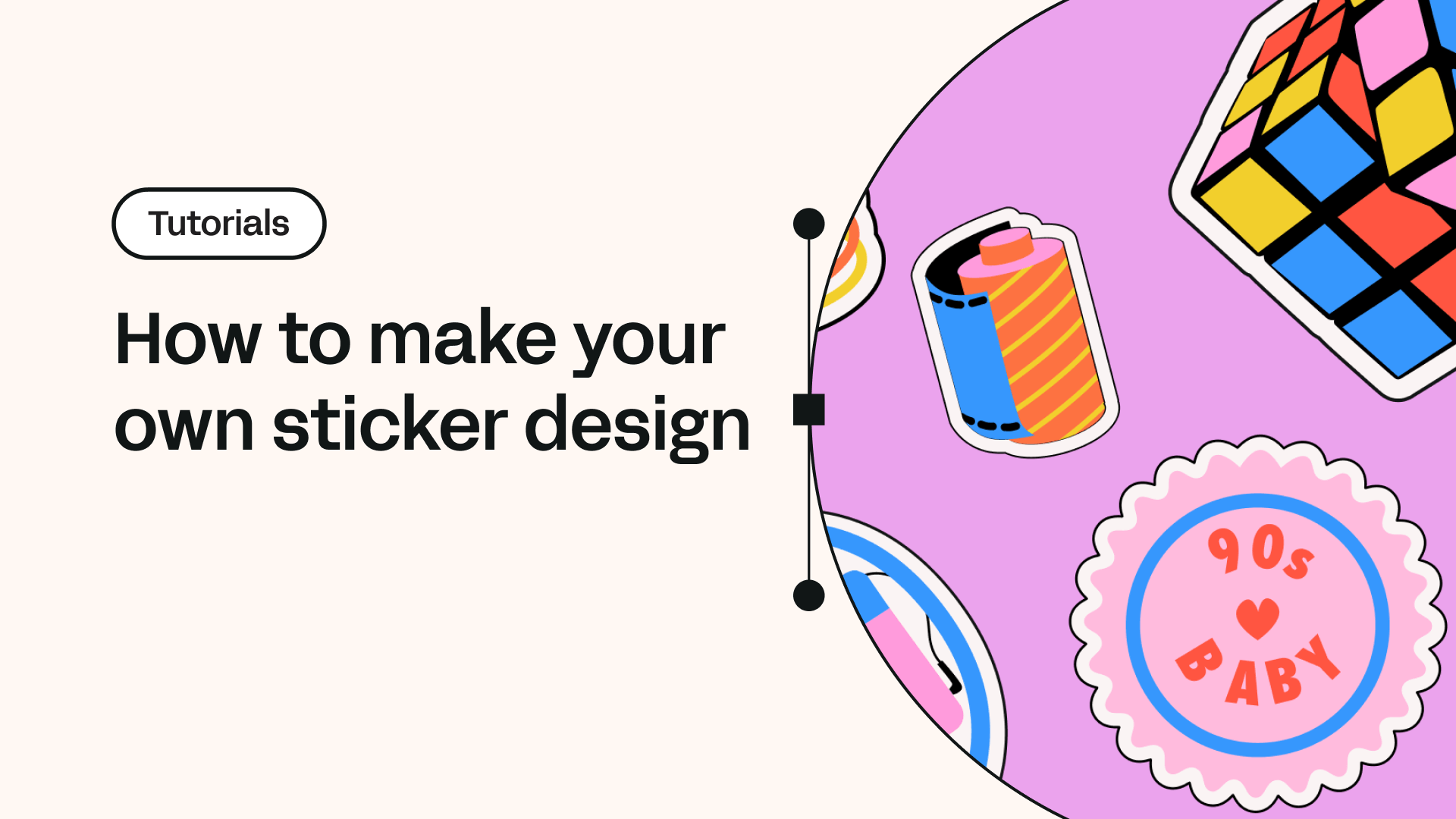
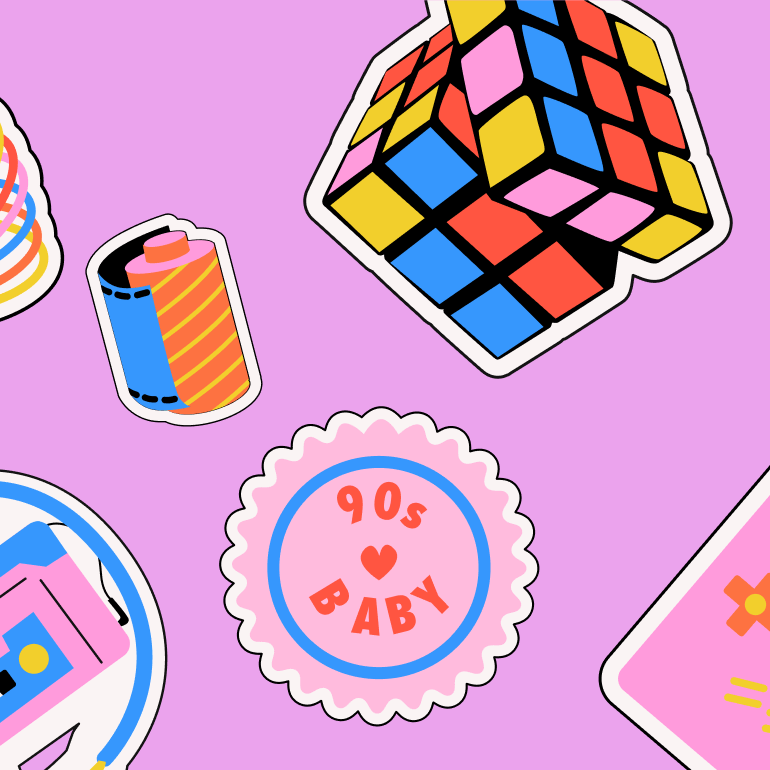
Share this!
Theodore Cipolla
Theodore is a contributing writer to the Linearity Blog.


:quality(75))
:quality(75))



:quality(75))
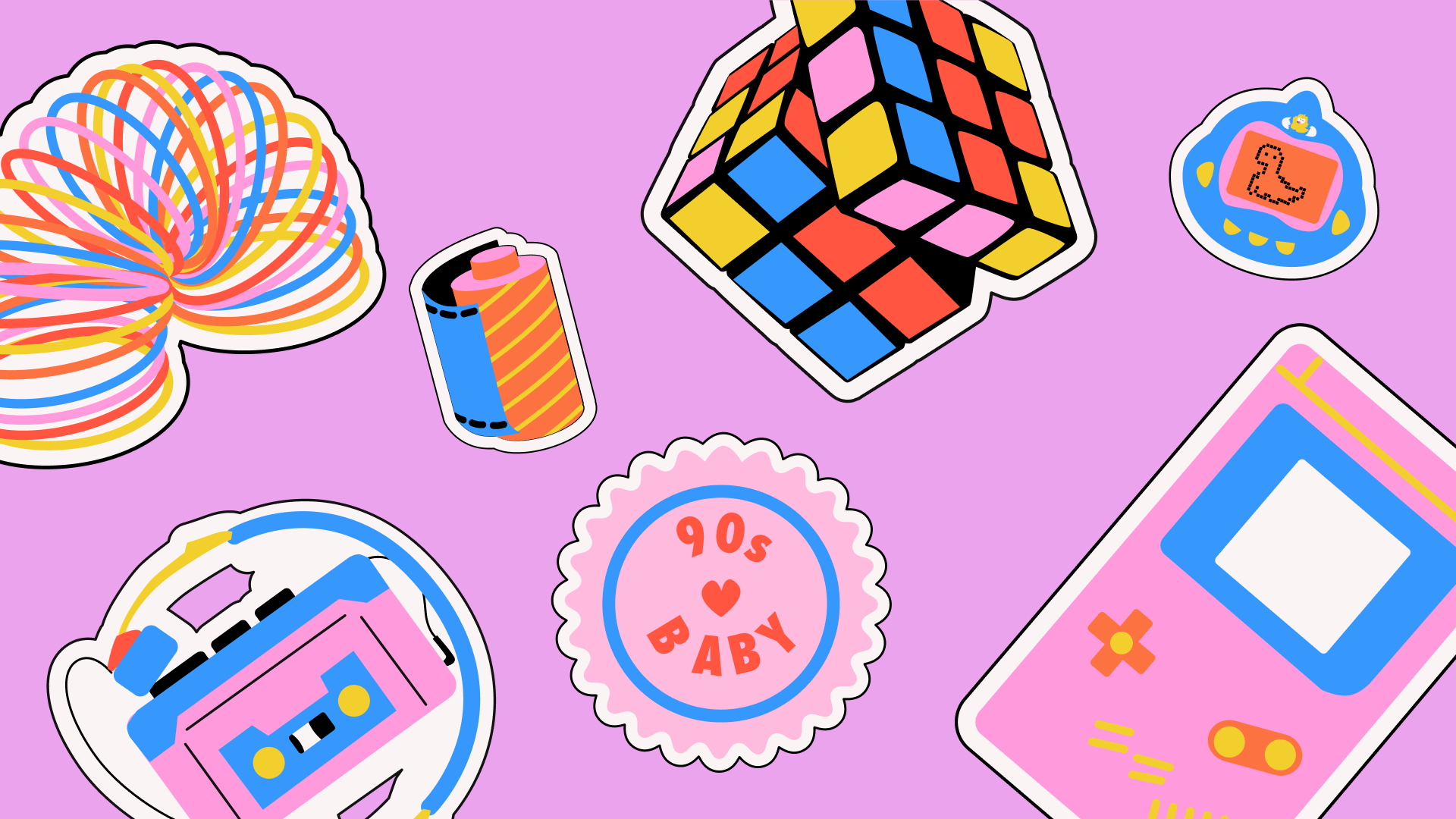
:quality(75))
:quality(75))
